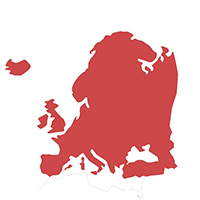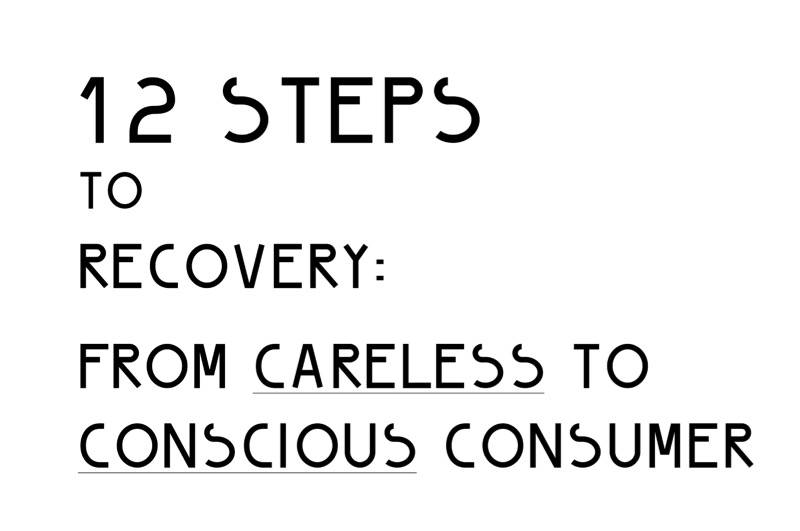12 Steps to Recovery: From Careless to Conscious Consumer
Jayden Holmes | June 5, 2015.
This is an intervention.
If you are reading this, you might already be aware you have a problem with addiction. An addiction that has been rapidly growing over the 20th and 21st centuries, spiralling out of control and threatening the very moral fabric of society.
It’s time to come clean. Admit to yourself; you are a consumer. It’s okay, many of us are. All you need to be a hippie these days is have an iPhone 4. But some of us have started to take steps to change our behaviour for the benefit of the seven billion other humans who cohabit our planet.
If your consumption habits are out of control, it might be time to embark on The Verb‘s ’12 Steps to Recovery’.
1. Admit you are (currently) powerless over consumption – that your life has become unmanageable.
By now, you will have accepted you have a problem. Your consumption habits have been costing you money, negatively impacting the lives of others, damaging the environment and preventing you from being truly happy.
Consumption is grossly skewed between the world’s richest and poorest. The richest 20 per cent account for 86 per cent of the world’s total individual consumption, while the poorest 20 percent only account for 1.3 per cent. Somewhere in-between the two is a happy middle ground—where we consume enough to meet our needs, but not so much to encourage our greed.
2. Believe and accept consumer help and information is available beyond your current knowledge, to help restore you to sanity.
If you’re not sure what conscious consumption looks like, there is plenty of information available (a Google search of ‘conscious consumption‘ yields 1,260,000 results). Consumption guides tend to be country specific, but some general rules are:
- Where possible, buy local. Buying from local, small scale stores (over chain stores) supports local producers and reduces your consumption miles. It also makes you more connected to the original source of products you are purchasing, reducing the chance of making a careless consumer choice.
- Buy less for more. Higher quality clothes (sometimes) cost more, because they last longer. Do some research though—the most expensive item isn’t always the most conscious (and vice versa)! Don’t get sucked in by crappy clothing marketing techniques like ’50 per cent off your second purchase’. Do you really need that second item anyway? If not, you’re not saving money, rather wasting it on something you’ll likely throw away.
- Reuse and recycle. For clothes, check op-shops (thrift stores) and friends’ closets for pre-loved threads before purchasing new ones. And if you’re not using something, consider giving it away. For food, reuse the same bags when grocery shopping and choose products with the least packaging (and food miles). Recycle any glass, plastic, paper or metal packaging (in other words: most of your waste) and compost organic food scraps.
3. Decide to turn your will and your life over to the practice over conscious consumption.
Conscious consumption can be practiced by everyone. There is a common misconception that buying ethical products costs more. However, this does not need to be the case!
As mentioned earlier, buying less for more can result in the same overall spend, with less overall waste. Fight fast fashion by embracing your own style, rather than ever-changing fads.
4. Make a searching and fearless moral inventory of consumption habits.
Keep a weekly diary of things you purchase. Seriously, try it. This will help you to understand your consumption behaviours provide a sense of how much money you can save by reducing expenditure on needless things. For example, you could monitor how much food you’re wasting on a weekly basis and change your grocery shopping habits accordingly.
5. Admit to yourself, and to another human being, the exact nature of your consumption habits.
Talk to a friend about what you’ve found out about yourself. If your friend is also suffering from overconsumption, encourage them to take this 12-step journey. Or even just a few of the steps. By sharing what you’ve found, you’ll feel responsibility to someone other than yourself, and will be more likely to stick to your resolve to consume more consciously.
6. Accept help in letting go of all your defects of character.
Nobody is perfect. Start small, accept advice of others who want to help, and gradually phase out toxic consumption habits as you discover their existence.
7. With humility and openness seek to eliminate your shortcomings.
Now that you know what you know, start to consume more consciously. Changing your consumption habits doesn’t have to be as dry as an A.A. (Alcoholics Anonymous) meeting!
8. Make a list of all beings or ecosystems that your consumption habits have harmed, and be willing to make amends to them all.
Careless consumption hurts. It hurts the environment, from where resources are pillaged, and it hurts people, particularly those at the bottom of the supply chain.
Think about the true cost of your clothing and who—or what—pays the real price.
9. Make amends to such entities, wherever possible.
This is easier than it sounds. Buy ethically produced clothes, preference things that last, embrace ugly food, don’t get caught up in fashion fads, and support organisations which source products and materials sustainably.
Remember money is power. You choose where to spend your money. Spend it wisely and think about the kind of practices you want to support.
10. Continue to take personal inventory of your consumption habits, and promptly admit any careless actions.
Continue to update your consumption diary beyond the first week. This can help to keep you on track and highlight moments of weakness. For example that time you shopped on an empty stomach and subsequently threw out 50 per cent of your weekly grocery shop.
11. Seek a way to fulfil your needs previously met through careless consumption with new hobbies or personal interactions.
Realign the way that you seek entertainment and find fulfilment, by removing consumption from the centre of everything. Too often we buy things we don’t need, with money we don’t have, to impress people we don’t like. (Thanks Fight Club). But seriously, go to a movie or talk to someone over coffee.
12. Having had a consumer awakening as the result of these steps, carry this message to consumption addicts, and practice these principles in all your affairs.
Now that you’ve become a conscious consumer, stop dreaming about that new product and start dreaming about a more sustainable planet.
What advice would you offer to people wishing to change their consumption behaviour? Comment below.
The Verb team have taken on the challenge of confronting our consumption habits. Over the next month, we will be reporting back on how we went—the highs and the lows. Join us by signing up, and let us tell your story too.














comment